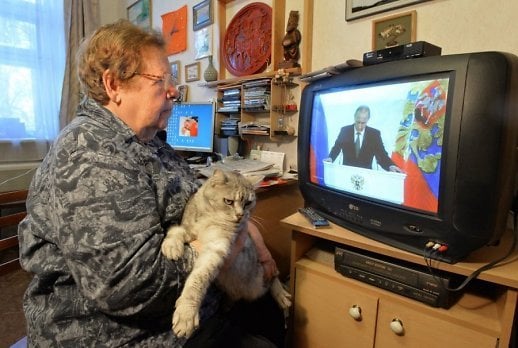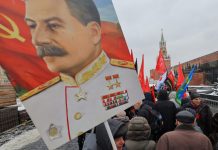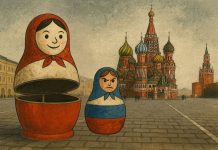
The Russian Federation’s propaganda and other aggressive actions in the information space have recently been the subject of buoyant discussion within the context of events in eastern Ukraine. Crucial, however, to an in-depth and factual debate on this subject is to take a look at the historical context and roots of the new Russian propaganda.
Soviet propaganda – still relevant?
Russia is officially the successor state to the Soviet Union – a modern empire in which propaganda was mastered to an art. The events of the past decades show that Moscow has managed to espouse the work of Soviet ideologists. That came about almost naturally, because using the old but strong foundation for “constructing” a new edifice of propaganda is simpler than starting from scratch. Furthermore, a propaganda system like this will be far more effective not only inside Russia (for domestic purposes) but also in the post-Soviet realm (aimed at the so-called near abroad). All the old propaganda storylines and concepts are still there in the society’s collective perception, therefore the task of the new propaganda system is to stir them anew, updating where necessary.
Soviet nostalgia has been widely used by Vladimir Putin ever since he became the country’s leader after replacing Boris Yeltsin in 2000. From the start, Mr. Putin’s policy was geared towards regaining power both in real and symbolic terms where regular action using information and symbols proceeded hand in hand; the national anthem of the Soviet Union was reinstated (albeit with different lyrics) and as of 2000 a red flag has been used as the flag of Russia’s armed forces (it was updated in 2003 but kept its red background). There was no intention of resurrecting the communist ideology of the USSR, because a new and authoritarian conservatism has come to replaced it (in Russia itself other names have been contrived for it such as the “power vertical” and “sovereign democracy”). And the church has been playing an ever bigger role in the power system. Another “tradition” will be remembered too – that of control of information and the channels disseminating it.
Propaganda’s main concepts
The ideological return to the past has encouraged building a new and modified propaganda system. This system is extremely intricate and one article cannot do it justice. Nevertheless, it is necessary to extricate its main concepts. This allows for an understanding of Moscow’s strategy in the information space and the reason as to why the conflict in eastern Ukraine follows a specific narrative.
As noted, in reconciling its new history with the past, Russia would adopt useful elements from each historical period. The key feature today that is borrowed from the Soviet period is not the anthem or the principle of information control. It’s the concept of Victory Day.
Victory Day has taken a central place in the ideology of today’s Russia. It symbolises both power (Russia celebrates its victory in the so-called Great Fatherland War, 1941-1945, claiming credit for winning the Second World War, thus emphasizing the Soviet Union’s role and belittling the Allies) and antagonism to the West (Western Europe uses 8 May as the date of the end of WWII, whereas Russia celebrates Victory Day on 9 May, the reason being the difference in time zones – Germany capitulated at 23:01 on 8 May 1945, when it was already 9 May in Russia). The approach to Russia’s role in the Second World War and evaluating that role is a propaganda litmus test that separates “us” from“ them”. “Us” are those who see the Soviet Union (and first of all its core, Russia) as the “saviour of Europe”, “the defeater of fascism” and the like. “Them” are those who are critical of such a view.
The concept of Victory Day as one of the latest bulwarks of Russian propaganda automatically means antagonism between Russia and the Baltic states. For Lithuania, Latvia and Estonia, events in the summer of 1940 were a great tragedy – the loss of independence. For Russia, (from an ideological standpoint) this was a smart strategy, winning time to prepare for the battle against fascism. Similarly, post-war resistance in the Baltic countries is viewed in Russia today as a movement of “fascists” and “bandits”, well in keeping with Soviet historiographical clichés.
According to this principle, all of “them”, i.e., those who question the heroic chronicle of the Soviet Union in the context of the Second World War, are habitually called “fascists” (although for the sake of historic justice it must be mentioned that fascism was Mussolini’s ideology in Italy and Hitler’s in Germany, the victory which Moscow celebrates each year on 9 May one was over national socialism, i.e., Nazism). For this reason Russia’s remarks that there is “resurgent fascism” in the Baltic states or the statement circulated recently by Moscow that a “fascist junta seized power in Kiev” should not surprise anyone.
It’s imperative to stress that concepts used by Russia’s new propaganda have only a superficial link with historical truth. That’s why protests in Kiev’s Independence Square (the Maidan) were supported by people who are described in Russian propaganda as “banderites”, linking them with the name of Stepan Bandera, a figure of radical Ukrainian national movement. In the case of Ukraine, Russian ideologists rather often use the terms “fascist” and “banderite” interchangeably, unperturbed by the fact that between 1941 and 1944 Bandera was imprisoned in Germany (Russian propaganda portrays him as a close associate of Hitler).
Fabricated stories about children
Propaganda is traditionally classified into white propaganda (e.g., social ads), grey propaganda (when facts are whisked up with contrived or untrue statements) and black propaganda (outright lies). Today in Russia the latter two types dominate. What’s interesting is that Russia’s black propaganda, buttressed by out-and-out lies, is often primitively and crudely choreographed. In the case the events in Ukraine, the “Story of a boy” is an example of this propaganda type. Last summer, a news broadcast on Russia’s Channel One presented a fabricated story about a boy from Donetsk whom Ukrainian soldiers allegedly crucified on a billboard. Just recently it showed a similar story about a teenager whom Ukrainian forces ostensibly pumped up with drugs and then forced to spy on the so-called separatists. The story was exposed as an outright lie.
The effectiveness of Russia’s new propaganda does not depend on how realistic the narratives it uses are or how easy they can be exposed as a lie. It would seem counterintuitive, since poor products whould in itself undermine propaganda’s effectiveness. But facts are facts. The overall impact of Russia’s propaganda is massive. Explaining this phenomena would require extensive research, but several convincing hypotheses suggest themselves even now.
First, Russia spends a lot of money on propaganda. An example is Russia Today, the international TV network and Russia’s propaganda mouthpiece in the West. Its planned budget for next year was raised from 11.87 billion to 15.38 billion roubles. Additional sum of 6.48 billion roubles was allotted to the state news agency “Rossiya Segodnya” (the former RIA-Novosti) which also plans a new radio channel and online portal called “Sputnik”. This project will broadcast Russia’s opinion to the world in 45 languages. All of this is just a part of Russia’s propaganda assets. It seems here that it’s all quantity at the expense of quality. Some Russian propaganda narratives are identifiable and exposed, but quite a lot of them are stealthy and reach their audience and successfully make their way into mass perception where they become entrenched.
The other important thing is that, as mentioned above, the Russia’s new propaganda has been using images and templates from the Soviet times, long-ingrained in mass perception. For this reason it’s not at all difficult to convince the people of Russia or of any other post-Soviet country that fascists are at work in Ukraine and the Baltic states and that NATO (another familiar enemy from the Soviet times) seeks Russia’s destruction. Unfortunately, most people in Russia won’t question these statements and will accept them as irrefutable truth.
By Viktoras Denisenko, Delfi




